Growing garlic sounds like it would be difficult, but it’s not! In fact, no matter which type you choose, the plants require very little care. In this post, you’ll learn all about how to grow garlic, from planting, fertilizing, watering, sunlight, and pruning, all the way through harvesting and storing.
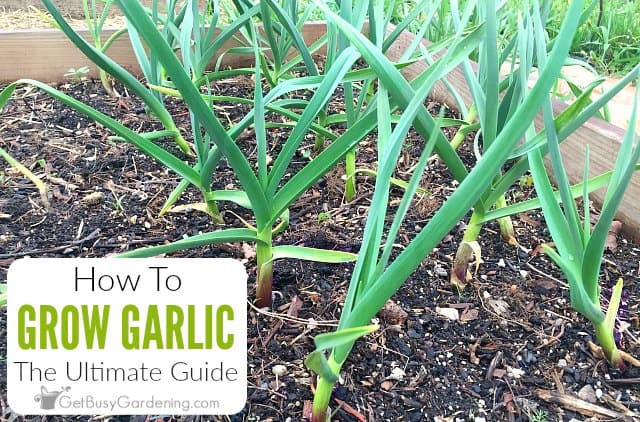
Garlic is used in just about every recipe you can think of. It is one of those seasonings that just makes everything taste better.
But do you know what’s better than tossing some store-bought cloves into an entree? Learning how to grow your own garlic! There’s nothing better than using it straight from the garden.
The great news is that garlic is actually rather easy to grow. In this detailed guide, you’ll learn all there is to know about garlic plant care, and exactly how to grow it in your own garden.
Garlic Quick Care Overview
| Scientific name: | Allium sativum |
| Classification: | Vegetable |
| Common names: | Garlic |
| Hardiness: | Zones 3-10 |
| Temperature: | 45-60°F |
| Flowers: | White, purple, blooms early summer |
| Light: | Full sun |
| Water: | Allow soil to dry between waterings, do not overwater |
| Humidity: | Average |
| Fertilizer: | High nitrogen fertilizer planting time-spring |
| Soil: | Rich, fertile, well-draining |
| Common pests: | Aphids |
Different Types Of Garlic
To be successful, it’s important to choose the right type of garlic to grow in your climate. There are two main types: hardneck and softneck. Here’s the details about each one.
Hardneck
If you live in a cold climate like I do, then be sure to buy hardneck garlic. Hardneck varieties have a hard, woody stalk (called a scape) that grows from the center of the bulb.
Hardnecks yield fewer cloves than softneck varieties, but they’re usually larger. Pruning the scapes is beneficial, and can increase the size of the cloves by 25-30%.
If left on the plant, the scapes will eventually bloom in clusters of pink, or greenish-white flowers. Aerial cloves, which are known as bulbils, will develop after the flowers fade.
Softneck
On the other hand, softneck garlic is best suited for growing in warmer climates. Unless the plant is stressed, softneck varieties rarely grow a flower stalk. So, they don’t normally require any pruning.
Softneck varieties yield many more cloves than hardneck; however, they are usually much smaller. Fun fact: the garlic that you see in the grocery store is usually softneck.
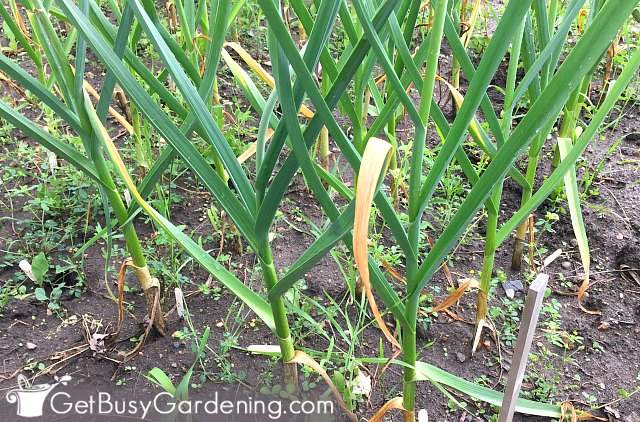
How To Grow Garlic
If you’re ready to try growing garlic, you’ll be happy to know that it really isn’t as difficult as you might think.
Even though there are a few differences between the two main types, their basic requirements are the same. So, you can follow these garlic care instructions for both!
Where To Grow Garlic
The best place to grow garlic is a location that gets full sun, and has fast-draining soil. Too much moisture can cause the bulbs to become diseased or rot, so avoid areas of your garden where water pools.
Crop rotation is also important, because plants in the Allium family take a lot of the nutrients out of the soil. So, it’s best to choose a spot that hasn’t been recently used for any other plants from the onion family.
Growing it in the same place over and over can also cause diseases to your crops. Instead, try to rotate the plantings every 3-4 years. Once you grow it in one spot, plant it in 2-3 different places before going back to the original location.
Related Post: How To Grow Onions At Home
How To Plant Garlic
If you’re new to growing garlic, you may be surprised to learn that you don’t plant the whole bulb at once. You break it apart into individual cloves, and then plant those.
You can learn exactly how to plant garlic here, but below are some quick tips…
- Prepare the soil – Remove any stones from the top six inches of soil. Work compost, worm castings, or manure into the bed, along with some granular fertilizer. Learn more about preparing the soil for planting vegetables here.
- Separate the cloves – Carefully separate each of the individual cloves from the bulb.
- Plant the cloves – Set the clove root-side down (pointy side up) about 4-6″ into the ground. Then cover it with 1-2″ of soil. Space each addition clove 6″ apart.
- Mulch the bed – If you live in the north, cover the bed with a thick layer of mulch to protect the cloves through the winter. Skip this step if you live in a warm climate.
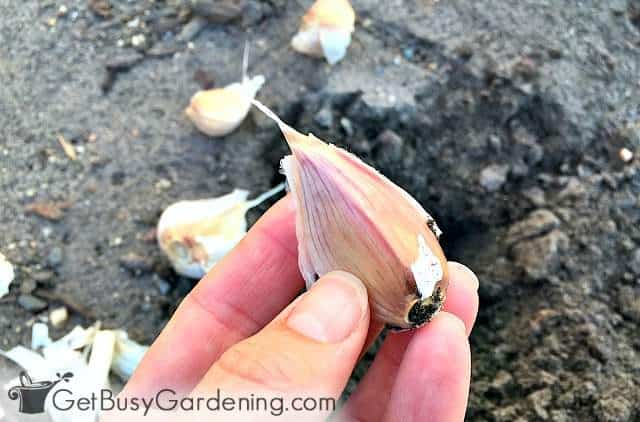
Garlic Plant Care & Growing Tips
As I already mentioned, it’s really easy to grow garlic, and the plants require minimal care. But of course, to produce the best crop, you’ll need to do some maintenance.
So, below you’ll find all the gory details about garlic plant care…
Watering Requirements
By far the biggest mistake that people make is overwatering. Too much water is a detriment to the plant, and will cause the bulb to rot.
It’s best to allow the soil to dry a bit between waterings, but never let it dry out completely. Check the moisture level by sticking a finger at least one inch into the soil.
If it’s wet, then don’t water it. A soil moisture meter is an excellent tool to help you get it right every time.
If it hasn’t rained, then water deeply every 7-10 days. Stop watering once the leaves begin to turn brown and die off. This means the bulbs have formed, and it’s almost time to harvest them.
Sun Exposure
Garlic plants require full sun to produce a healthy crop. So be sure to give them at least six hours of direct sunlight per day.
Best Soil For Garlic
The right soil is super important for growing garlic. It does best in a loose, well-draining soil that has been amended with organic, nitrogen-rich ingredients.
That’s because it is a heavy feeder. So be sure to add worm castings, compost, or a balanced all-purpose fertilizer to the soil before planting.
Also, ideally the soil pH should be between 6.5 and 7. A pH probe is a quick and easy way to test the acidity of your soil.
Garlic also performs best in beds where it doesn’t have any competition with weeds or other plants. It’s a good idea to add a layer of mulch on top of the soil to help keep the weeds under control.

Fertilizing Garlic
Another important part of successful garlic plant care is fertilizer. As I mentioned above, it is a heavy feeder. So, to get the most from your efforts, it’s important to feed the plants regularly during their active growing season.
When the leaves begin to sprout out of the ground in the spring, start feeding the plants using an organic liquid fertilizer.
They love fish emulsion, or compost tea (which you can get in a concentrate, or buy compost tea bags to brew it instead).
Stop fertilizing garlic in mid-summer when the leaves begin to turn brown and die back.
Pest Control
It’s very rare for garlic plants to have any type of pest problems. In fact, their pungent smell can actually work to deter many would-be pests from the garden.
But sometimes aphids can become a problem. If you find bugs on your garlic plants, wash the leaves with an organic insecticidal soap. Or make your own by mixing one teaspoon mild liquid soap with one liter of water.
Apply sprays in either the early morning or evening when the sun isn’t as intense to avoid possible damage.
Also, always test any pest control products you plan to use on one leaf before spraying the whole plant.
Pruning Garlic
One of the beautiful things about growing garlic is the scapes you get from hardneck varieties. Before the bulbs are ready to pluck out of the ground, you’ll find stalks growing in curves and swirls above the leaves of the plant.
To produce larger bulbs, prune the scrapes off before the flowers open. Be sure to use a clean and sharp pair of pruners so you don’t damage the stem.
You don’t have to discard the scapes. They’re edible and have a similar flavor to the garlic itself, so it’s like getting a bonus harvest! Use them in recipes, sauté them, or add them to salads and casseroles. Yum!
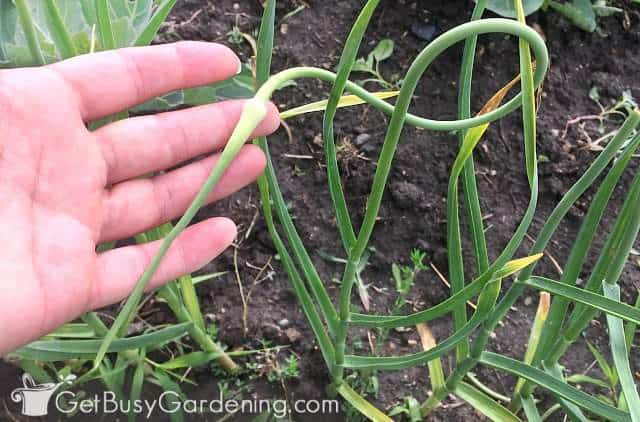
How To Harvest Garlic
You’ll know garlic is ready to harvest once most of the foliage has turned brown. When half or more of the leaves have died, then it’s time to dig up the bulbs.
This usually happens sometime in July or August, depending on when you planted them.
To harvest garlic, dig the bulbs several inches away from the base of the plant so you don’t accidentally cut or bruise them.
Related Post: How To Make Pickled Garlic (With Recipe)
Curing & Storing Garlic
After digging up your garlic, it’s very important to allow bulbs to cure (dry out) before storing them.
When properly cured, the skins will shrink up around the bulb, sealing them, and making your harvest last for many months. Follow these steps to properly cure them…
- Lay the plants out to dry for 2-3 weeks in a shady area. I like to put mine in the garage so they won’t get wet.
- When the roots feel brittle and dry, rub them off along with any loose dirt. Be sure to leave the papery skins intact.
- Do not get the bulbs wet or break them apart before storing them.
- Tie the stems in bunches, braid them, or cut them off a few inches above the bulb.
- Store garlic bulbs on screens or slatted shelves in a cool, dry, airy location.
- Don’t forget to set some aside for replanting.
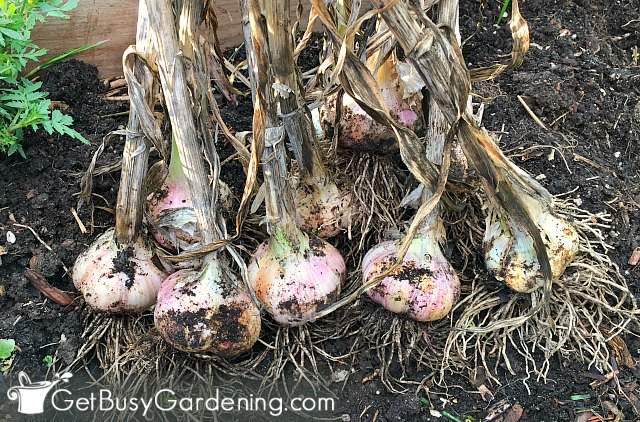
FAQs About Growing Garlic
Below I will answer some of the most commonly asked questions about garlic plant care. If you still have questions after reading this post and the FAQs, ask them in the comments below.
How long does it take to grow garlic?
Some varieties may vary, but it generally takes 7-9 months for garlic to grow after planting it.
Can you plant garlic cloves from the grocery store?
You certainly could experiment with growing grocery store garlic. However, keep in mind that it’s usually softneck, so it won’t survive in cold climates.
Also, since it wasn’t meant to be used for growing, grocery store cloves may not perform as well as seed garlic.
Can you plant garlic that has sprouted?
Yes. As long as it hasn’t grown to be weak and spindly looking, then you can plant sprouted garlic cloves.
When should you feed garlic?
It’s best to amend the soil at planting time, and then start feeding garlic regularly once it begins to grow in the spring.
Can I grow garlic from a clove?
Yes, you can definitely grow garlic from a single clove. The bulbs are made of multiple cloves combined together. When planted properly each clove can grow into a full-size bulb.
Garlic is one of the most versatile plants you can grow in your veggie garden. It takes a little work, but in the end, it is worth it. Plus, now that you know exactly how to grow garlic, you may never have to buy it at the store again!
If you want to learn all about growing your crops vertically, then you need my book, Vertical Vegetables. It has everything you need to know to be successful, plus almost two dozen detailed step-by-step projects that you can build in your own garden! Order your copy today!
More Vegetable Gardening Posts
- How To Grow Peppers: The Ultimate Guide
- How To Grow Potatoes In Your Garden
- How To Grow Your Own Sprouts
- How To Grow Blueberries In Pots Or The Garden
- How To Grow Cucumbers In Your Garden
- How To Grow Brussels Sprouts In Your Garden
- How To Grow Passion Fruit At Home
Share your tips for growing garlic in the comments section below!
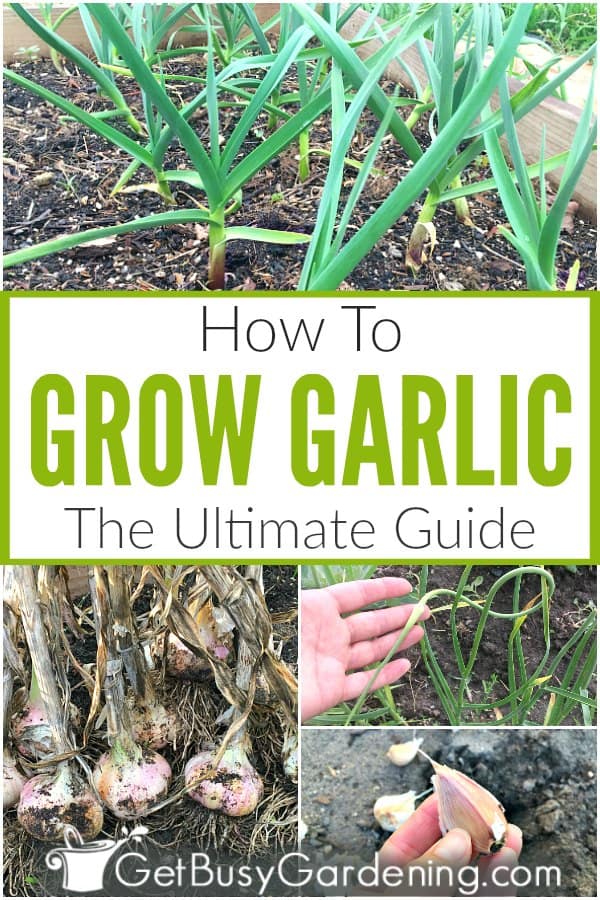
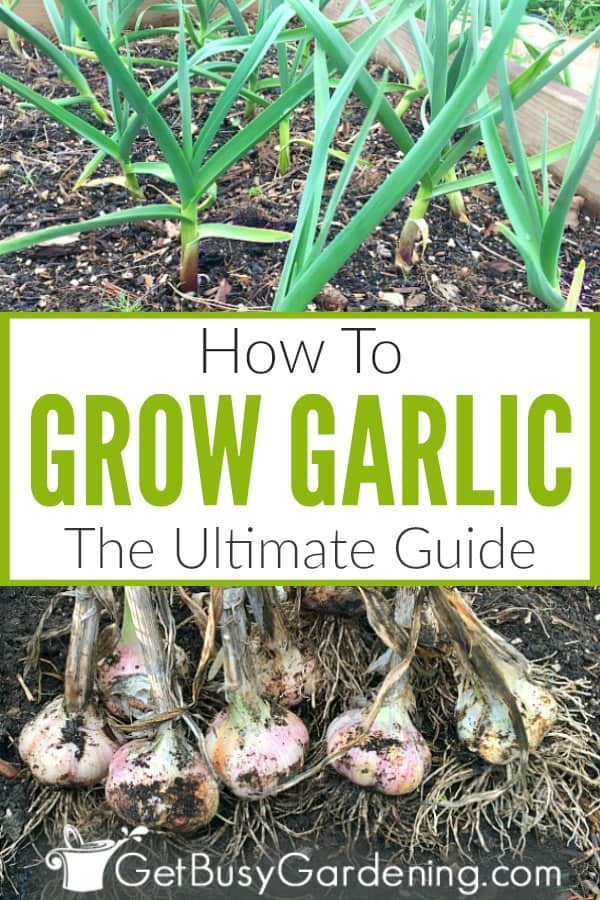
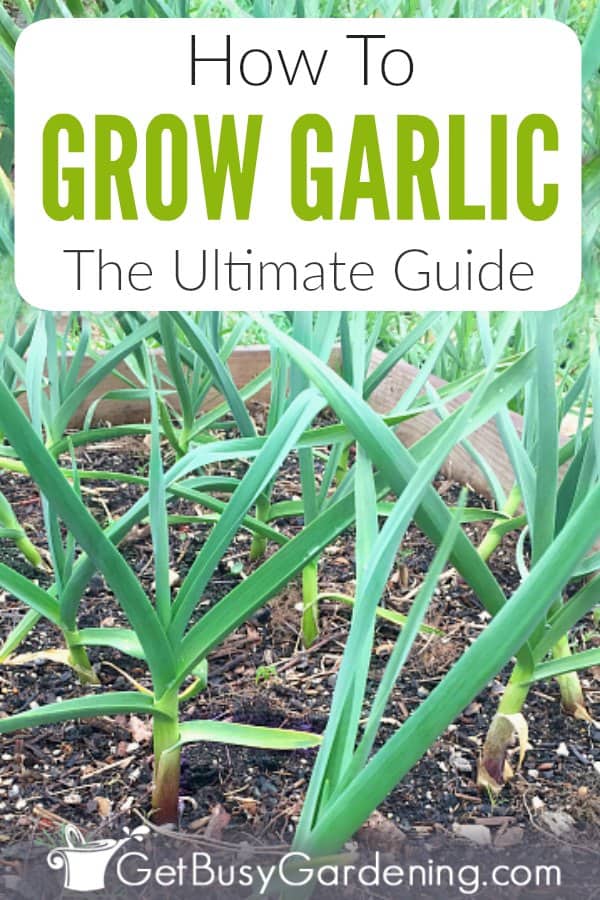



Mahmoud Fatemi says
Can i plant garlic in spring or summer?
Amy Andrychowicz says
If you live in a warm climate with a long growing season, then you can plant garlic in late winter/early spring. Here are the specific details about how and when to plant garlic.